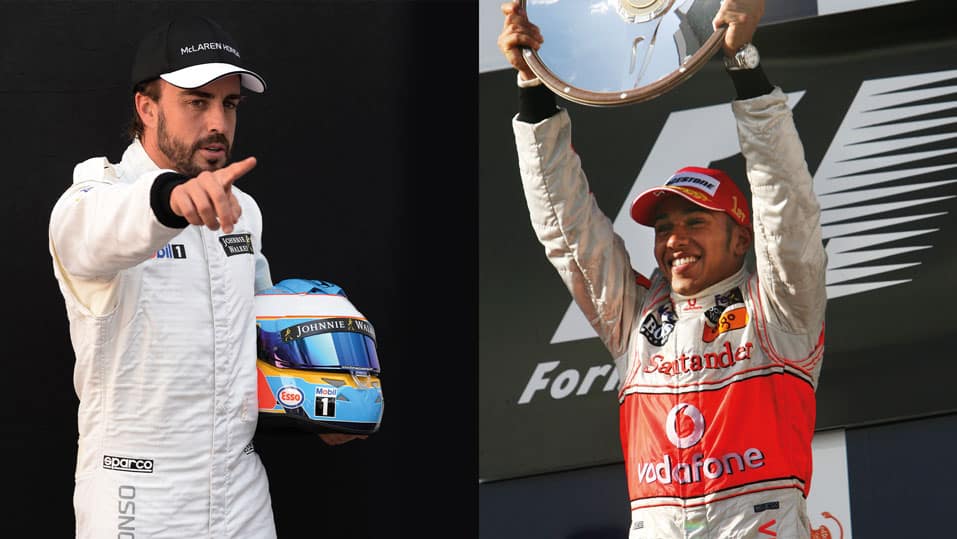Born winners
While running McLaren’s F1 communications, Matt Bishop got a close-up view of what makes these two world champions tick

Grand Prix Photo
I worked with Lewis Hamilton at McLaren for five seasons (2008-12) and with Fernando Alonso at the same team for two and a half (2015-July 2017). But, although they are both nervily brilliant multiple world champions, magnificent on track and fascinating off it, those two collaborations were very different.
When I started work with Hamilton, in early January 2008, he was just about to turn 23. He had won four grands prix for McLaren the year before, and had missed the drivers’ championship by a single point, but, even so, his mood at that time – like the mood of all of us at Woking in the wake of an annus horribilis that had cost us the constructors’ title and $100m to an FIA fine – was one of defensive pessimism. We all felt bruised, especially Ron Dennis, who had been mercilessly pummelled by Max Mosley’s iron fist in a velvet glove, that ferocious but patrician FIA president’s favourite weapon.
Nonetheless, Hamilton won the world championship in 2008, clinching it in the most dramatic way possible, famously passing Timo Glock’s Toyota on the last corner of the last lap of the last race of the year. I was in the McLaren garage that afternoon, shouting myself hoarse, and I will never forget it.
Lewis won five grands prix that year, and over the next four seasons he added 12 more, but another serious championship chance never came his way, for he finished fifth, fourth, fifth again and fourth again in 2009, 2010, 2011 and 2012. Then, frustrated by our failure to give him a car capable of winning titles, and sweet-talked by Niki Lauda and Ross Brawn, he departed for Mercedes, a move that was pilloried at the time but with hindsight is hailed as a masterstroke. The years 2013 and 2014 were nondescript for us Woking folk – no wins at all, just one top-three each for Kevin Magnussen and Jenson Button – and in 2015 Alonso returned, surprisingly to some observers who remembered the bad terms on which he and McLaren had parted company at the end of 2007. I had never worked with him before, and I was expecting fireworks. When, very early in 2015, it became abundantly clear that the car we had given him, the McLaren-Honda MP4-30, was never going to trouble the scorers in any meaningful way, I was pleasantly surprised to find that no pyrotechnics eventuated. Instead, he was quiet, calm and philosophical, eager to urge our engineers, in the UK and Japan alike, to push for improvements.
Occasionally he was mischievous – his famous deckchair stunt at Interlagos, his infamous team-radio cry of “GP2 engine!” at Suzuka, humiliating the Honda head honchos at home – but for the most part he put a brave face on. I guess $40m a year made it easier. The next year, 2016, was barely better, and 2017 was worse. And that, as far as the McLaren-Honda marriage was concerned, was that.

Bishop, Hamilton and Jenson Button in 2012, right before that Mercedes move
Getty Images
And what of Hamilton? Clearly, the years I worked with him at McLaren were far more successful than the time I spent with Alonso there: one world championship against none; 17 wins against none; 36 podiums against none. So we are not comparing apples with apples. But it was immediately clear to me, and has remained always evident, that these two great drivers share a number of qualities, foremost among which is a truly unshakeable determination. Moreover, although of course they are both excellent qualifiers, it is their racecraft that sets them apart: fair yet combative; tactical yet forceful; reliable, error-lite, yet prepared to leave no inch of asphalt unexploited when a banzai charge is required.
Alongside that determination and raw pace they share an almost scary level of ambition. It is that scary level of ambition that keeps Alonso battling for podiums now, as fit as ever despite being just weeks away from his 42nd birthday, and it was that same scary level of ambition that Hamilton showed often when I worked with him, and especially at the Hungaroring in 2009.
The McLaren-Mercedes MP4-24 started the 2009 season dog-slow. Poor Heikki Kovalainen got nowhere with it, and even Hamilton could qualify it only P15 (Australia) and P13 (Malaysia); its first two grands prix. Thereafter our engineers slowly and surely began to improve it, its performance especially on slower circuits gradually becoming respectable, until we arrived at tight and twisty Hungaroring, where Lewis qualified it fourth. The next day he raced it brilliantly, recording the first-ever grand prix win for a KERS-equipped car.
Immediately afterwards, most of us McLarenites felt one emotion: relief. Not Lewis: he was in eighth position in the drivers’ world championship standings, a country mile in arrears, yet, as I met him after the podium celebrations and led him to the media pen for his post-race TV interviews, he batted away my congratulations with a polite but impatient: ‘No, that doesn’t matter. Do the sum. If I win every race from now until the end of the season, can I still be champion? Do the sum now.’ Arithmetically, if Jenson Button, Rubens Barrichello, Sebastian Vettel and Mark Webber were to have scored almost no further points for the remainder of the season, it would indeed have been possible. Was it remotely probable? No, it was not. But, to my mind, that moment, in microcosm, showed why Lewis Hamilton was, and is, special. Winning is everything to him. Alonso is exactly the same.

